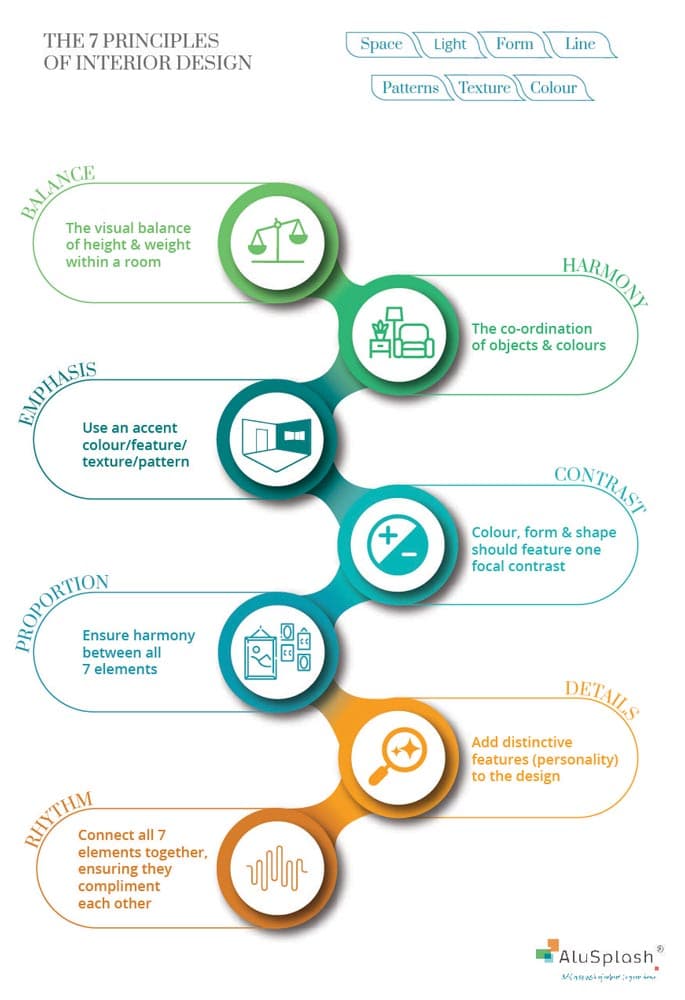A variety of interior design styles may be applied to give your house and furniture a fresh appearance. Nonetheless, the art of interior design requires equal priority to be given to all seven basic interior design principles, as well as maintaining a balance between the seven various parts of interior design.
Combine this information with experience and experimentation, and you’ll be well on your way to designing a beautiful house. To assist you to understand these interior design concepts, we’ll go over each one in-depth and discuss how you may use them to create your perfect house. Let’s get into it.
1. Balance
Balance is achieving visual harmony in the room by ensuring that the pieces are positioned evenly.
The proper placement of elements in a space promotes visual balance, making the interior appear more pleasant to the eye. This interior design idea takes into account the perceived weight of things based on their shape, color, texture, or pattern. A pillow, for example, can be rather heavy on the eyes if it is misaligned or overly ornamented with textures and patterns.
Adding equal weight to both sides of a room also helps to create equilibrium. This may be accomplished through the use of tangible things as well as the incorporation of a variety of interior design components into the area.
2. Unity
The value of unity in home design cannot be stressed enough.Every piece of furniture, style, and decorating must complement one another to form a unified whole. The harmony and regularity of all design aspects contribute to the beauty of your home design.
The unity concept emphasizes a sense of homogeneity or harmony among design aspects. Similar colors, textures, patterns, equal spacing of items, or repetition of pieces to create visual continuity are examples of these.
Simply said, when parts are well-picked, they appear to work well together. For example, if a space contains a range of shapes and textures, you may still achieve unity by choosing a single color scheme.
3. Rhythm
Rhythm in design, like music, is all about building patterns of contrast and repetition to create visual appeal. This may be accomplished by repeating the same shapes or colors at varying intervals. Its objective is to draw your attention around the room.
Repetitive rhythms may be easily created by using the same fabrics or position comparable things across the area. However, employ repetition with caution because no one wants to listen to the same music on repeat all day!
4. Proportion and Scale
The proportion and scale notion is the best way to create a sense of belonging among things in a room. Size, shape, and color must all be in balance with one another and with the space. This idea is important in knowing how to use the surrounding area, whether it is a huge or a tiny room.
Proportion is the connection between two objects, while the scale is how the size of one object corresponds to the size of another. A large, overstuffed sectional, for example, will be out of scale in a small area. A little coffee table in front of two massive sofas may look odd and out of place.
5. Emphasis
The employment of an accent in the room, such as color, element, texture, or pattern, to draw attention is known as emphasis in interior design. A room with no focal point is forgettable and uninteresting.
Choosing one thing in the space to act as the focus of attention, around which the rest of the décor will revolve, is the principle of emphasis. This technique is used by radial balancing to direct attention to the desired center of emphasis in the room.
6. Contrast
In interior design, contrast is generated by combining two or more highly dissimilar shapes. Again, this may be accomplished by the use of color, shape (form), or space.
The simplest approach used in Oppein apartment projects to produce contrast is by color, such as by painting contrasting colors such as black and white. You may also balance two distinct shapes together, such as a circular mirror and a rectangular dining table. Positive space (space occupied by items) and negative space (empty space between objects) are also great ways to create contrast without overwhelming the area.
7. Details
The principle of details stipulates that the minor elements should not be disregarded. When it comes to details, nothing is too minor or inconsequential to be noticed. Everything from embroideries on the cushions to cabinet knobs to framed artwork on the wall adds a little bit to the overall interior design. The slightest touches are what separate a good interior design from a superb one.
Final Word
There you have it: the seven interior design concepts that might help you build a beautiful home. Remember to use these while planning your next remodel!

